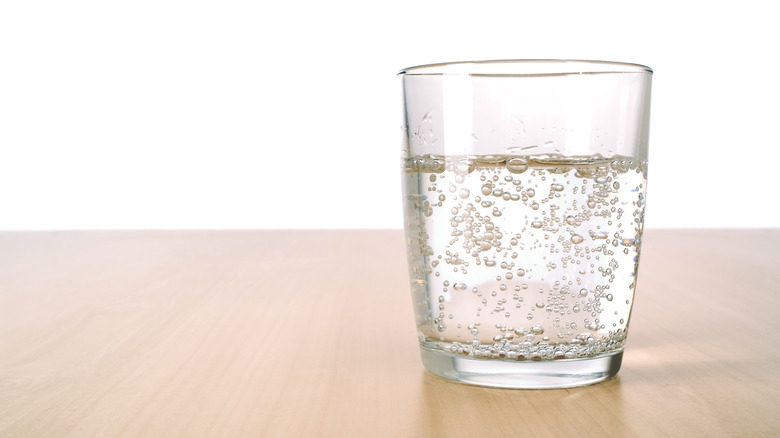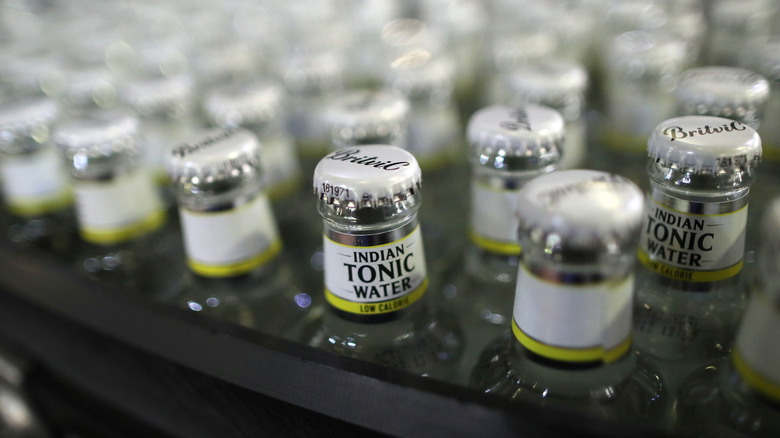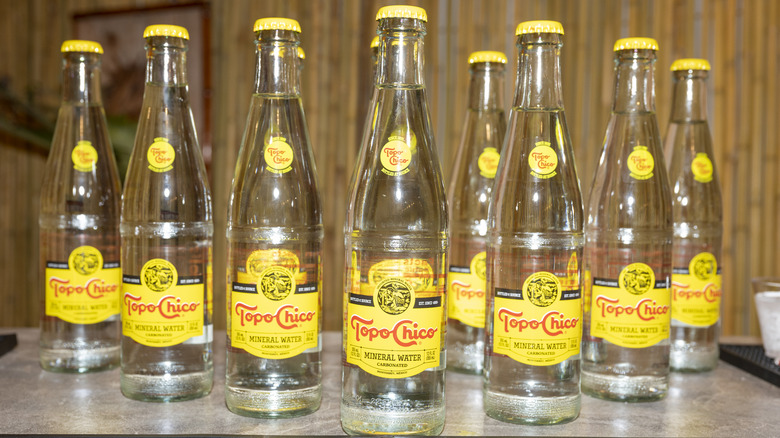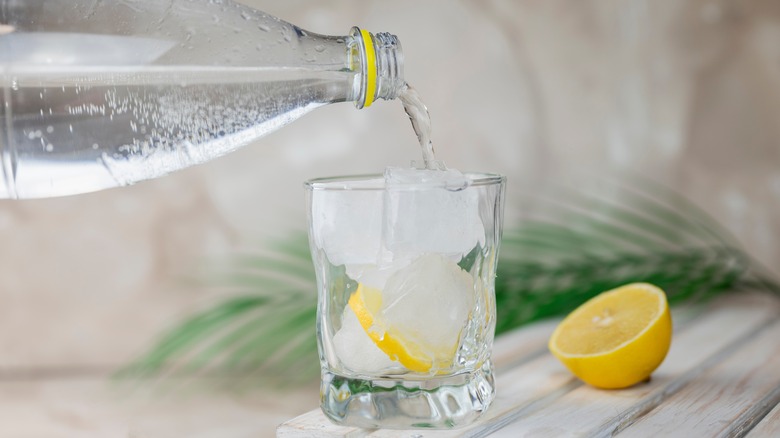Seltzer Vs. Tonic Water: What's The Difference?
Seltzer, mineral water, club soda, and tonic water all have similarities, and the terms are sometimes used interchangeably. At a glance, it's nearly impossible to tell them apart visually. Clear, sparkling, and flavored lightly if at all, these carbonated drinks serve similar purposes. Their origins are similar, too — after all, tonic, seltzer, and club soda were all inspired by naturally sparkling mineral water.
For thousands of years, carbonated mineral water was valued for its purported health benefits but could only be found at natural springs. That all changed in the late 1700s when methods of producing man-made carbonated water using carbon dioxide were discovered. Over the following centuries, scientists and entrepreneurs began perfecting and expanding on the initial process, mimicking the effects of natural springs to sell what they called "medicated water." As the industry grew and expanded, so did the offerings, which evolved from cure-alls to fashionable drinks and cocktail mixers.
What is seltzer?
Before it was a catch-all term, seltzer was originally a specific brand of carbonated water named after the German town of Niederselters, which was famous for its naturally carbonated springs. Modern seltzer is artificially carbonated, typically sold without additional minerals, and is traditionally flavorless. However, the term is used fairly loosely, so drinks labeled as seltzer can also contain flavors and additives.
Jewish immigrants brought seltzer to the United States and helped popularize the use of soda siphons. Nowadays, flavored seltzers and their alcoholic counterparts are all the rage. La Croix first hit the market in 1980, but it was New York Seltzer founded in 1982 that popularized flavored seltzers amongst the general public.
By the '90s, the drink's popularity fizzled out, and the company declared bankruptcy. It wasn't until the 2010s that flavored seltzer came booming back. Health-conscious customers appreciated a lighter, brighter alternative to syrupy sodas, and the craze ushered in a newfound demand for alcoholic seltzers as well, like the wildly popular White Claw.
A class unto its own, seltzer makes for a perfect blank slate. It works as a mixer, as a key ingredient for light and fluffy baked goods, or simply as a great way to stay hydrated. You can mix it with milk and chocolate syrup for an egg cream or use it as a substitute in recipes that call for tonic or soda water, but be aware that seltzer has less flavor than other carbonated waters.
What is tonic water?
Unlike seltzer, soda water, and mineral water, tonic water can't really be called "water" at all. Sweetened with sugar or corn syrup and flavored with quinine, it's more of a soft drink. In fact, it's considered one of the first soft drinks to hit the market.
Tonic water was initially used as a medicine. In the 1840s, British colonizers stationed in India used quinine — a drug derived from the bark of the cinchona tree — to prevent malaria. Inspired by the health benefits of mineral springs, companies like Schweppes began selling carbonated tonics infused with quinine. A precursor to modern sodas, these tonics were often sweetened with sugar and flavored with fruit to cut the bitter taste of quinine. Soldiers began using them as mixers while sailors added citrus to stave off scurvy, and thus, the gin and tonic was born.
These days, tonic water is ubiquitous. Found behind bars worldwide, it's an essential ingredient in many popular cocktails and mocktails. Tonic water still contains quinine, though the United States Food and Drug Administration regulates the ratio of quinine to water, rendering it no longer medicinal.
The early 2000s sparked renewed interest in cocktails. Accordingly, new tonic brands popped up, sourcing quinine from across the globe and experimenting with new flavors like elderflower and yuzu. If you're a traditionalist, drink it with gin. For a unique Japanese beverage, pair it with espresso.
What is mineral water?
Mineral water comes from natural springs and is bottled at the source. Since it comes straight from the ground, it's often high in essential minerals. Sometimes, it's naturally carbonated but, unlike seltzer, club soda, or tonic water, carbonation isn't the defining feature.
According to the U.S. Food and Drug Administration, mineral water has to have at least 250 parts per million of dissolved solids, aka minerals. Companies are not allowed to add minerals to products labeled "mineral water;" all minerals must occur naturally. However, mineral water can be carbonated during the bottling process even if it isn't naturally carbonated.
Like tonic water, mineral water has been used medicinally throughout history. While you'll likely be met with a laugh or an eye roll if you call a gin and tonic "medicinal" now, many people still drink mineral water for its purported health benefits.
Mineral water can be beneficial. It can be particularly useful for people who struggle to get minerals through their regular diet. Mineral water is typically high in the likes of calcium, magnesium, sodium, and zinc. But, since mineral water occurs naturally, the health benefits depend on the source.
What is club soda?
Think of club soda as the halfway point between seltzer and mineral water. Like mineral water, club soda is full of minerals, except its mineral content and carbonation don't come from natural sources. The original club soda was produced in 1877 by Cantrell & Cochrane, an Irish soft drink manufacturer. The drink was commissioned by the Kindare Street Club, hence the name "club soda."
The term "soda water" also refers to water that has been artificially infused with minerals and carbonation. However, soda water has a looser definition than club soda. Club Soda is often confused with tonic water since both drinks are often used as cocktail mixers. However, Club soda doesn't have the same slightly sweet, slightly bitter taste of tonic water or the calories that come from the sweeteners.
While club soda has a fairly neutral taste, it does tend to have salty or citrusy undertones. These flavors come from the minerals, which often include potassium sulfate, sodium citrate, and potassium bicarbonate. The salty flavor can enhance the taste of mixed drinks, bringing out hidden flavors. And, since the minerals are added artificially, companies can blend them in ways that complement alcohol.
Club soda is a classic mixer for drinks like Tom Collins, gin Ricky, or vodka soda. You can mix it with non-alcoholic beverages, too, like Kumbucha or lemonade. However, it's not typically drunk on its own; the extra sodium in club soda makes seltzer a better choice to drink straight up.




